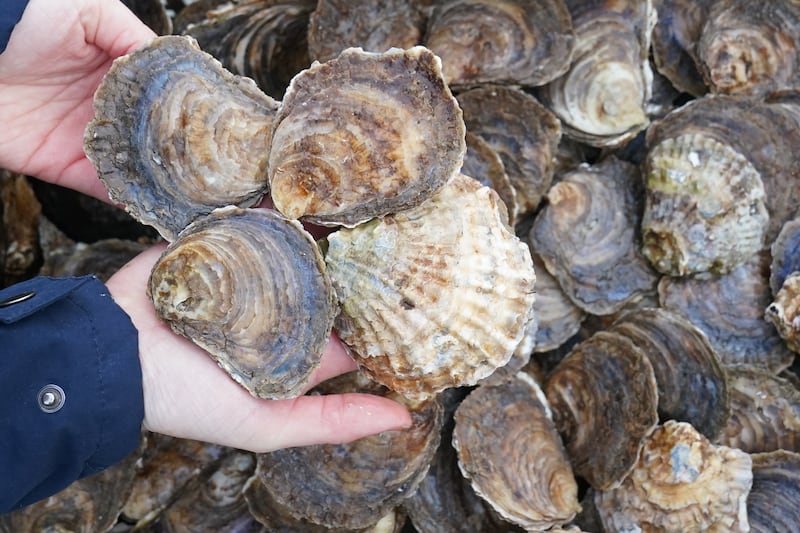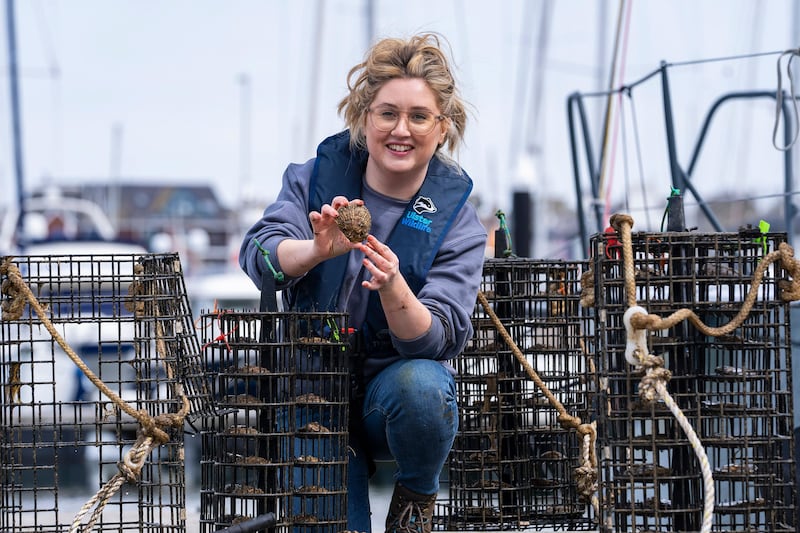OYSTERS – you either love them or hate them. While an increasing number of Irish people delight at their taste, just as many recoil in horror at sight of these slimy specimens nestling in half shells, bathed in their own salty juices.
Whether you fancy tackling the world oyster eating championship or just want to sample these delicacies for the first time, the upcoming Hillsborough International Oyster Festival will provide the perfect opportunity.
Often seen as a delight of the rich, the Irish history of the oyster dates back to Victorian times, when it was one of the staple foods of Belfast's poor – they were sold by seafarers called 'the fadgies', Irish speakers from the Omeath Gaeltach who settled in Charlemont Street off Smithfield after the Famine.
Oyster farming hasn't changed much since Victorian times, as I witnessed on a lovely sunny day walking through seaweed, shells and stones to reach 12,000 mesh oyster bags grown on top of tressels.
The location was the picturesque Killough Bay, near Downpatrick, home of Killough Oyster Ltd.
Owned by Patrice Bonnargent and assisted by his son Luc (21) – who chose to follow in his father's footsteps rather than pursue a sports degree – the 4.5 hectare site near Kilclief Castle is stocked with bags of sterile oyster seed imported from hatcheries in Britain and France.
Because of its sheltered location, the area is tailor made for oyster growing, and the fresh water from the River Quoile merging with the seawater gives Killough oysters a unique taste.
"The minerals make a difference," explains Patrice, who likens such variations in flavour to that of wine from different regions.
"Here we have both fresh water and sea water producing a slight nut-like taste which is not too salty."
Frenchman Patrice first came to Northern Ireland 27 years ago. He worked in the fish export business in Kilkeel before buying the license to oyster farm in Killough in 2003.
Initially run on a community basis, Patrice has since expanded the business four-fold, last year producing in excess of 40 tonnes of Pacific oysters.
He also supplements his income by cultivating muscles.
Initially an export-only business, last year he took the decision to start supplying Irish wholesalers and restaurants with fresh local produce.
"The food scene here has changed in recent years, it's become more sophisticated. There is a greater appetite for seafood, helped by growing numbers of tourists."
The oysters can only be worked at low tides when they are clearly visible. Patrice and Luc then wash and purify the oysters for 42 hours under UV light to kill off potential bacteria. This is done in their 'factory', basically a cliff-side shed.
Apart from this one piece of apparatus and a tractor and trailer to transport the oysters from the seashore, no sophisticated machinery is required.
"All you need is wellies, waders and strong muscles," laughs Patrice.
The biggest export market is France, where oysters play a key part of the Christmas season.
"The French prefer natural products on their table," explains Patrice. "Oysters are grown in the water, nothing else is done to them."
Indeed, oysters are a healthy food: low in fat, they contain essential amino acids and are a good source of copper, iron and zinc, all of which boost the immune system.
But what of their fabled aphrodisiac qualities?
"We recently had a few guys call by looking to buy some as they were cooking dinner for their girlfriends," laughs Luc. "They get this label because of their high levels of zinc, but you would need to eat about 20 dozen of them to have any effect."
Andy Rea, head chef at the Mourne Seafood Bar in Belfast, will be manning an oyster stall at the Hillborough Oyster Festival on Saturday September 5, as well as cooking at a new Gourmet Pop-Up Restaurant Night with Danny Millar from The Parson’s Nose, Derek Patterson from The Plough Inn and Karl Banks from The Hillside on Thursday September 3.
He is delighted by the growing popularity of oysters here, selling in the region of 1,600 a week.
"We should celebrate our oysters," he tells me. "They are the envy of the world because our water temperature is so cold, which makes the meat plumper.
"When we dug the foundations for our restaurant in Bank Street, we found oyster shells. Back when we had linen factories and the shipyard here, working class people had oysters in their lunch box as a snack.
"It's a massive part of our history and culture that we have forgotten about."
Purists swear by eating them alone, but what can we have with these ivory morsels besides a sip of champagne?
"The French have serve oysters with sherry vinegar and shallots and it's called migonette," says Andy, who prefers his oysters with a glass of stout.
"Oysters lend themselves to a little bit of soy and lemon juice and wasabi, which is like horseradish."
And should you chew or swallow?
"I like to chew an oysters but a lot of people beg to differ. Oysters for me are the most perfect seafood because they give a total taste of sea. If you swallow and bypass that, you defeat the purpose."
For first timers, Andy's advice is to try them cooked firm, baked tempura style with a butter.
"When we first opened the restaurant we had a load of kids call in to try them and it was almost like doing a 'bush tucker' trial," he laughs.
:: The Hillsborough International Oyster Festival runs from September 1 to 6. For further information visit Hillsboroughoysterfestival.com
RECIPES
Oysters Kilpatrick
Karl Banks, The Hillside
Ingredients
12 oysters
3 rashers of thin sliced streaky bacon
2tbsp Worcestershire sauce
1tbsp ketchup
2 drops of Tabasco sauce
1 shallot
1tbsp olive oil
Wedge of lemon
Method
Pre-heat the grill. Heat the oil in a pan and add the bacon slices cook until crispy. Finely dice the shallot and add to the bacon fry for a further 1 to 2 minutes and remove from the heat. Add the Worcestershire sauce, ketchup and tabasco replace back on the heat for 2 minutes. Shuck the oysters and return, with any juices, to the bottom shell. Spoon over the sauce, then place the oysters on a small baking tray, grill for 2 to 3 minutes.
Serve on a nice plate or wooden board and garnish with wedge of lemon
Oysters Rockefeller
Danny Millar, The Parson’s Nose
Ingredients:
6 fresh oysters in their shell
55g butter
½ small onion, chopped
1 tbsp chopped fresh parsley
55g spinach, chopped
55g fine breadcrumbs
Method:
Preheat the grill to its highest setting. Open the oyster shells, remove top and loosen each oyster from base of shell. Leave to one side and keep cool. Melt the butter in a pan and cook the onion and parsley for 2-3 minutes, until softened. Add the spinach and cook until wilted. Add the breadcrumbs and cook for 1-2 minutes.
Place a teaspoon of spinach and breadcrumb mixture onto each half oyster shell to cover the oyster and place a small lump of butter on top of each. Place the oysters onto a baking tray and transfer to the grill to cook until golden-brown.








